- This photo
feature tells how tantric rituals are performed at Tarapith, West Bengal.
Tantra’s rituals are shown everywhere as disgusting, and a heavy dose of erotica is added for good measure. The latter gives Tantra a tinge of what Western scholars term ‘antinomian methods’, or socially unaccepted methods. Their understanding is that since Tantric rituals happen often, but not always, in crematoriums, there must be something ‘transgressive’ about them, something which crosses socially acceptable borderlines.
They look with Abrahamic eyes at something they cannot understand even with their deep knowledge of Sanskrit tinged with their puritanical ideas of good and evil. They are trapped within the shadows of the German philosopher Friedrich Nietzsche; and are still occupied with Nietzsche’s books, Beyond Good and Evil
(1886).
Western
philosophy to date is a footnote to Nietzsche as Nietzsche was a footnote to
Plato. Contemporary scholars like Hugh B. Urban distort Tantra to something
drawn from the fevered imagination of scholars who have little knowledge of the
subject and willy-nilly, write on Tantra as they filter it through their
structuralist Abrahamic eye.
Let us briefly consider the problems with Urban’s 2003 essay, The Power of the Impure: Transgression, Violence and Secrecy in
Bengali Śakta Tantra and Modern Western Magic.
To start with, Urban refers to Michel Foucault’s work to foreground his discussion on the nature of the transgressive in his eagerness to cherry pick from Krsnananda Agamavagisa’s work and yoke it to Foucault’s work. This is a misplaced and unfortunate yoking of two very different worldviews or, ‘Weltanschauungs’. Weltanschauung is not the cognate of the Indic understanding of philosophy as ‘darshana’ or (hermeneutically valid method of reciprocal) ‘seeing’. This is not remotely akin to the ‘gaze’ of Foucault. Urban is very focused but skewed in his understanding of Tantra. Sadly, he knows what his readers expect from him: titillation and magic. He writes:
“Specifically, I want to focus on the role of impurity in the ritual traditions of Hindu Sakta Tantra and modern Western magic. Since their first encounters with Indian religions in the 18th and 19th centuries, Western scholars have been simultaneously fascinated and repulsed by the tradition of Tantra. A form or religious practice infamous for its deliberate use of impure substance and transgressive rituals, Tantra has long been for Western readers a source of both moral repugnance and tantalizing allure.”
Like David Gordon White, Urban is acutely aware of his intended reader’s response. Gordon White is widely known for his provocatively titled book, Kiss of the Yogini (2003). The book’s cover design too is symptomatic of the Western obsession with the body and its construction as a site for desire. This is produced through the influence, on the one hand of Abrahamic Weltanschauung and on the other hand, on the equally stifling body-politics produced by leftist and far-left thinkers like Alain Badiou.
Therefore, the time has come to reveal to the world at large the intricacies of Tantric ritual through a pictorial essay as practiced by a living Bhairav at Tarapith (West Bengal) in the here and the now.
There is nothing
antinomian about Shakta Tantra except the fact that its practice is best done
in crematoria. This is for two reasons. One is that it is only in a cremation
ground that one is reminded by the transience of life. The other reason is more
theological rather than philosophical. It is a patrimony of Shakta Tantric
faith that Shakta deities (who are emanations of the Holy Mother and
inseparable from her) prefer being worshipped in crematoria.
Just since someone chooses to worship in a building and someone in a crematorium does in no way make the latter worship inferior. Just since someone says that the Holy Eucharist is the flesh of Christ and the sacerdotal wine is Jesus’s blood, it does not follow that those who partake of daily enactment of the Last Supper during Mass, she is a cannibal.
Religious texts
communicate to us through metaphors, synecdoches and lengthy digressive
similes. The Song of Songs in the
Hebrew Bible is not erotica but it is essential to Judaism and Christianity
because it transmits the experience of God-intoxication through humanly comprehensible
terms. We are familiar with the bliss of physicality; therefore, the Song of Songs makes sense. The Tantras
take recourse to sexual imagery for the very same reason.
In the case of
Tantra, the likes of Gordon White and Hugh Urban accuse us of sanitizing
Tantra. Their ignorance of the trope of the disdain of the body in all branches
of Sanatana Dharma is monumental and, one suspects, is deliberate. They want to
play up to the gallery.
The intention of the next six pictures with notes is to clear the muck hurled at Tantra by perhaps well-meaning but often way off the mark scholars who approach the subject without practicing it. It makes more sense to read the Jesuit priest, Karl Rahner on the Holy Eucharist than to read René Girard and his scapegoat theory to understand the changing of the Eucharistic Bread to the Flesh of Christ, or transubstantiation.
Rahner performed transubstantiation daily while Girard only wrote books and lectured to others about the impossibility of effecting transubstantiation daily. Rahner was a Catholic priest who happened to be a prolific writer while Girard remained only a prolific theorist all his life. This with the caveat, that Girard was never the spokesman for any denomination of Christianity unlike say, Walter Brueggemann today. Both Brueggemann and Yuval Noah Harari speak of the Egyptian Pharaoh’s time. Brueggemann is a Unitarian minister, while Harari’s main task is to demolish both Judaism and Christianity. Yet the Pharaoh is within God or YHWH’s time according to the Bible.
Thus, Harari’s scintillating global bestseller, Homo
Sapiens is populist, atheistic and leftist propaganda masquerading as scholarship while Brueggemann’s truly scholarly and spiritual book Sabbath as Resistance: Saying No to the Culture of Now is hardly known by
anyone even within Christian circles.
The point is
that it is best to know about Shakta tantra from its practitioners and not from
scholars.
One more instance will hit home the half-baked learning of Americans about Indic religions. I had the misfortune of reviewing Sarah Jacoby for Prabuddha Bharata in the early part of 2019. Jacoby’s widely praised monograph turned book, Love and
Liberation: Autobiographical Writings of the Tibetan Buddhist Visionary Sera
Khandro is a disaster in terms of historicity and the reality of Vajrayana,
but the book has gone on to be a classic in Western academia. It became so by
locating Sera Khandro as virtually a prostitute. This is very far from the
truth, and is shameful.
This is also the fate of Tantra in the hands of scions of first world religious academies like the American Academy of Religion. Jacoby’s book reads like a fairytale by an adolescent waking up to desire while transitioning to adulthood. I read the book, and I was repelled by it and expressed my repulsion against Jacoby’s factually incorrect portrayal of the mystic Sera Khandro.
It is in an
effort to correct distortions of Shakta Tantra that
I am releasing ten pictures for the world to see what really happens in a
Tantric ritual invoking Mothers Tara and Bagalamukhi and beings from the
other world.
The first picture is of a Tantric sadhu (which is not the same as a monk); Tantrics call each other sadhu. The sadhu is sitting on a recently lit pyre thinking of the eternal things. The things of man are momentary, and all things will pass, and we are mere pilgrims or sojourners here.
All the photos
are recent and taken within the main cremation ground of Tarapith, West Bengal.
Tarapith is a
siddha peeth; that is where Sri Vamdev and later, many others received the
eight major Tantric siddhis. Tarapith is where Sage
Vasistha established the Holy Mother as Maa Tara. These pictures are copyright of author.
These pictures,
particularly the ones with the photos of the sacred fire should never be circulated
by people who have had no valid Tantric initiation. Tantra shastra tells us
clearly that householders who have not been initiated in Tantra should not use
these pictures for any purpose due to reasons which are best not given here. My
Gurudeva allowed me to photograph them for the sake of a better understating of
Tantra.
Neither was anybody drunk with liquor, nor was any woman present there. These are not rituals one hears from David Gordon White and Hugh Urban. Perversion will always win over ‘deha ninda’, rejection of the body/flesh/sarx when one begins with Tantra as its selling point.
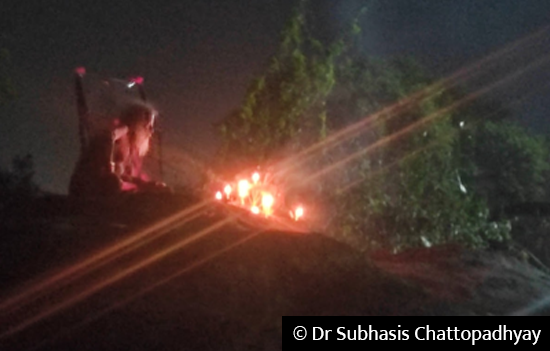
In the following
two photos we can see the decoration of the altar within the crematorium at
Tarapith in preparation for the worship of two of the Ten Mahavidyas.
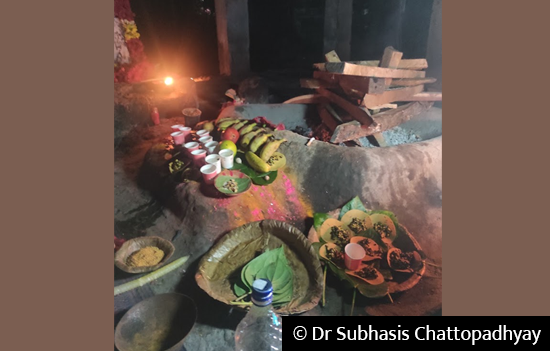
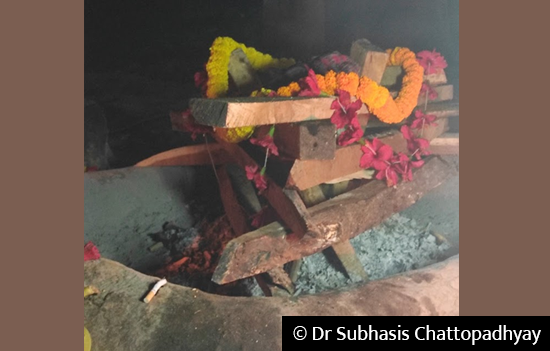
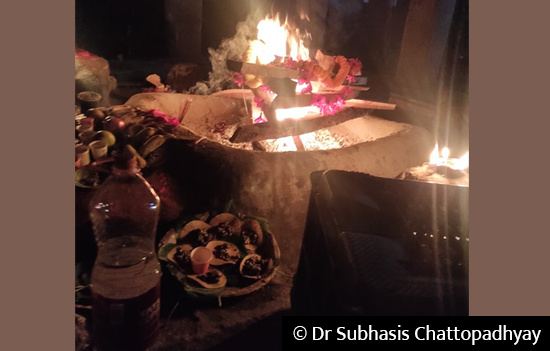 Havan Kund
Havan Kund
While the Puja
is going on
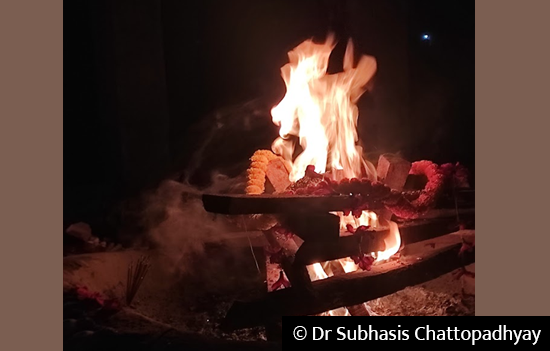 The fire that purifies all our Tamasic tendencies.
The fire that purifies all our Tamasic tendencies.
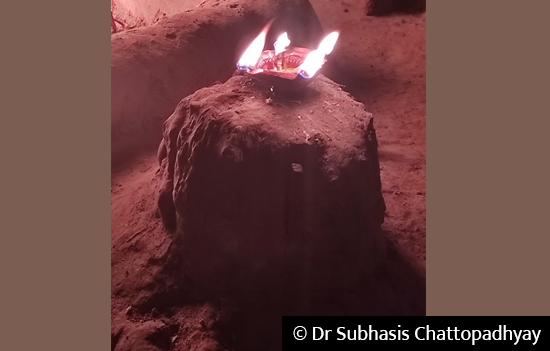 Diyas/Oil wick lamps kept burning just outside the havan kund.
Diyas/Oil wick lamps kept burning just outside the havan kund.
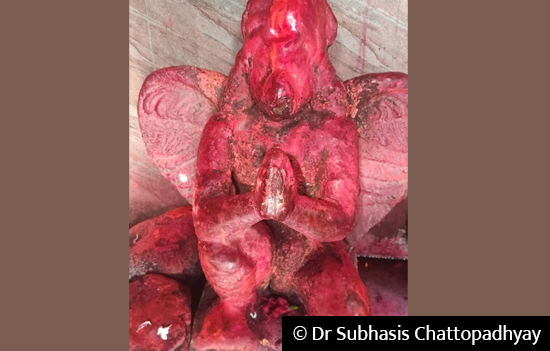 Lord Garuda with Sri Vishnu at Tarapith.
Lord Garuda with Sri Vishnu at Tarapith.
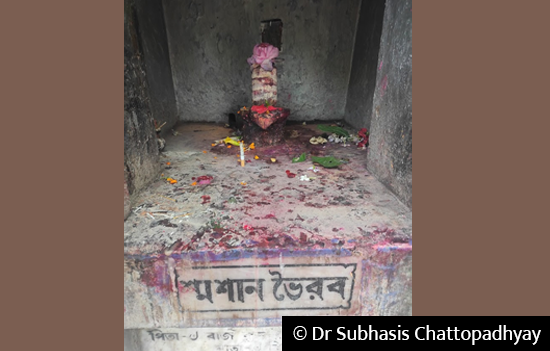 The Bhairav of the Shamsan/Charnel Ground.
The Bhairav of the Shamsan/Charnel Ground.
Tarapith, as has been mentioned above, is a Siddhapith. And many associate only Maa Tara with Tarapith. Some scholars often do not understand that the boundaries between Vaishnavism and Tantra are fluid. This fluidity can also be seen between Vaishnavism and Shaivism. In this picture the truly unified nature of our Dharma is seen --- Lord Shiva, Sri Vishnu are worshipped in this temple within the main temple’s boundaries.

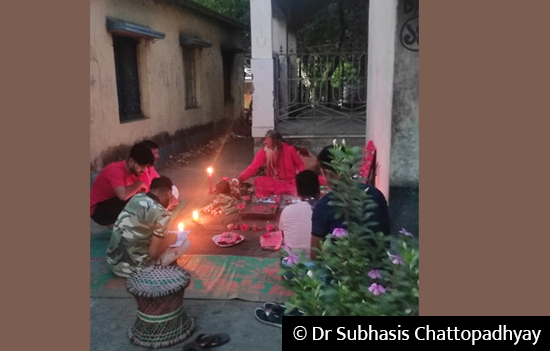 A Tantric whom I do not know doing Pujas for devotees near the quarters for the sadhus.
A Tantric whom I do not know doing Pujas for devotees near the quarters for the sadhus.
Do not contact
the author for further queries.
Harih Om. Jai
Maa Tara.
गुरू ब्रह्मा गुरू विष्णु, गुरु
देवो महेश्वरा गुरु
साक्षात परब्रह्म, तस्मै
श्री गुरुवे नमः
Translated as Guru is like Brahma-the creator. He creates or inculcates knowledge in the minds of the students. Guru is like Vishnu – the preserver. He maintains or preserves the knowledge in the students. Guru is like Shiva-the destroyer.
To read all
articles by author
Author Dr. Subhasis Chattopadhyay is a theologian of comparative religion.
To read all
articles on Tantra
Also read
1. What Tantra is
not
2. Shaktipat – A Constant shower of Grace
3. Sixty-four
Yoginis
4. Vigyan Bhairav
Tantra
5. Tantra – a much misunderstood path to liberation
6. Worship of God
as Mother in Indian Tradition
7. Album Chausath
Yogini Mandir, Jabalpur
8. Album 64 Yogini
Temple, Bhubaneshwar
9. The
Ten Mahavidyas